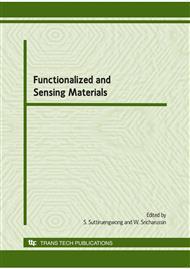p.413
p.417
p.421
p.425
p.429
p.433
p.439
p.443
p.447
Conductivity and Dynamic Mechanical Studies of PVC/PEMA Blend Polymer Electrolytes
Abstract:
The ionic conductivity and mechanical properties of poly (vinyl chloride) (PVC)/poly (ethyl methacrylate) (PEMA) polymer blends containing LiN(CF3SO3)2 as doping salt has been studied using electrical impedance spectroscopy (EIS) and Dynamic Modulus Analysis (DMA) as a function of polymer blend ratios and lithium salt concentration. The film with PVC/PEMA composition of 65:35 obtained the highest conductivity with good transparency. DMA showed that both the storage modulus (E') and the glass transition temperature (Tg) of the PVC/PEMA is increased with PEMA concentration. In the case of PVC/PEMA-LiN(CF3SO2)2 films, the conductivity was found to increase with concentration of salt added with a maximum in conductivity at 35 wt.% LiN(CF3SO2)2. The Tg values of the doped films was found to increase with concentration of salt such that the film with the highest conductivity value has the highest Tg.
Info:
Periodical:
Pages:
429-432
Citation:
Online since:
January 2010
Price:
Сopyright:
© 2010 Trans Tech Publications Ltd. All Rights Reserved
Share:
Citation:


